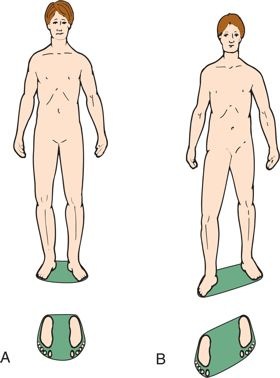Base of Support: Difference between revisions
No edit summary |
No edit summary |
||
| Line 8: | Line 8: | ||
The '''base of support (BOS)''' refers to the area beneath an object or person that includes every point of contact that the object or person makes with the supporting surface. These points of contact may be body parts e.g. feet or hands, or they may include things like crutches or the chair a person is sitting in. | The '''base of support (BOS)''' refers to the area beneath an object or person that includes every point of contact that the object or person makes with the supporting surface. These points of contact may be body parts e.g. feet or hands, or they may include things like crutches or the chair a person is sitting in. | ||
[[Image:BaseOfSupport.jpg]] | |||
== <span>Significance </span> == | == <span>Significance </span> == | ||
Revision as of 19:03, 26 August 2014
Original Editor - The Open Physio project
Top Contributors - Sheik Abdul Khadir, Admin, Rachael Lowe, Garima Gedamkar, Kim Jackson, Scott Buxton, Simisola Ajeyalemi, Wanda van Niekerk, WikiSysop, Claire Knott, Lucinda hampton, Jess Bell and Olajumoke Ogunleye
Introduction [edit | edit source]
The base of support (BOS) refers to the area beneath an object or person that includes every point of contact that the object or person makes with the supporting surface. These points of contact may be body parts e.g. feet or hands, or they may include things like crutches or the chair a person is sitting in.
Significance [edit | edit source]
The BOS is an important concept to understand to understand an individual's ability to Balance. The balance term is defined as the ability to manintain the line of gravity (passing through the Centre of Gravity) within the BOS.
In gait, the base of support has been defined as the horizontal stride width during the double-support phase when both feet are in contact with the ground and the whole-body center of gravity (CG) remains within the BOS.[1] A wide base of support (BOS) has long been believed to be a hallmark of unsteady gait. [2]
Clinical Implication
[edit | edit source]
- Wellar et al found that decreased stride width was closely correlated with fall frequency and dynamic stability. [1]
- The majority of the gait cycle is spent in single leg support during which the BOS is minimized to the width of the supporting foot. [1]
- Thus when a patient is tried for gait, the wider base of support by means of walking aids such as walker, crutches,cane,etc is provided to acquire more stability. As the condition of the patient improves, the BOS can be reduced.
Recent Related Research (from Pubmed)[edit | edit source]
Failed to load RSS feed from http://www.ncbi.nlm.nih.gov/entrez/eutils/erss.cgi?rss_guid=1VYNXIuyMSaYLp6NOZ89nQHu3FNvOH39WDKmuJAdLkR9mA6s8S|charset=UTF-8|short|max=10: Error parsing XML for RSS







